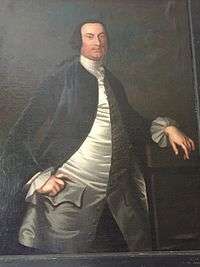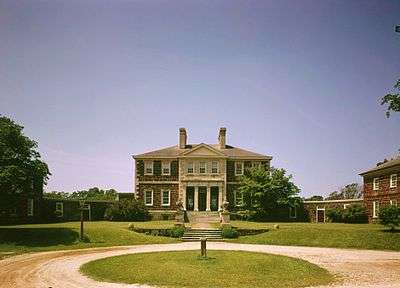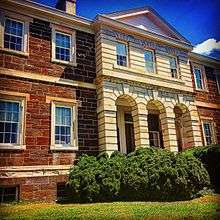John Tayloe II
| John Tayloe II | |
|---|---|
 | |
| Born |
May 28, 1721 Old House, Richmond County, Virginia |
| Died |
April 18, 1799 (aged 77) Mount Airy, Richmond County, Virginia |
| Resting place | Mount Airy, Richmond County, Virginia |
| Nationality | British/American |
| Occupation | Planter, Agent |
| Known for | Virginia Planter, Builder of Mount Airy |
Colonel John Tayloe II (28 May 1721 – 18 April 1779) was among the richest plantation owners in colonial Virginia.[1] He served in public office including the Virginia Governor's Council, also known as the Virginia Council of State.[2] He has been described as a "model Virginia planter, planting tobacco, wheat and corn and raising livestock."[3] A fourth-generation plantation owner from the Tayloe family of entrepreneurs, he took over the management of the Neabsco Iron Works during the 1740s, likely after his father's death in 1747. The Tayloe family of Richmond County, including John Tayloe II, his father, John Tayloe I, and son, John Tayloe III, exemplified gentry entrepreneurship.[4]
Early years

Tayloe was born in Richmond County at Old House, located on Rappahannock River,[5] two miles west of Mount Airy, an estate his grandfather had purchased and upon which he built a home. Tayloe was born to John Tayloe I (1688–1747) and Elizabeth Gwynn, daughter of David Gwyn and Katherine Griffin. He had an elder brother, William Tayloe (1716–1726) who died at age 9, a twin sister named Elizabeth, and younger sister named Ann Corbin Tayloe, born 25 August 1723.[6] Tayloe was educated in England.[5]
Career
After Tayloe's father died, Tayloe inherited a large fortune including 20,000 acres (8,100 ha) and 320 slaves. In 1756, he bought the Occoquan Ironworks company, eventually running it as one business with the Neabsco Ironworks.[7] During the American Revolution, Tayloe supplied the Virginia Navy with "Cannonball, Plant, and Pigg iron".[5] He served in public office as a member of the county court and he sat on the Virginia Council of State.[5] He had approximately 250 slaves.[8] Among his servants were a band of musicians.[9] He was an influential member of the King's Council, under Lord Dunmore, and of the first Republic Council, under Governor Patrick Henry.[10] Tayloe was a member of the House of Burgesses of Virginia 1774.[11]
Tayloe owned more than 20,000 acres (8,100 ha) in the Northern Neck, including land on both sides of the Rappahannock. The Mt. Airy estate was originally acquired by his grandfather, William Taylor (late Tayloe), who bequeathed the property to his son, John Tayloe I, and he to Tayloe II.[9] Tayloe built the mid-Georgian plantation house; construction began in October 1760 and was completed by 1765. It is listed on the National Register of Historic Places as a National Historic Landmark. The property had a 1 mile (1.6 km) long horse racetrack, a deer park,[9] a bowling green, terraced gardens, and a burial ground.[5] The portraits at "Mount Airy," are considered one of the finest private collections in America.[10]
His plantation was supported by interdependent farms (Forkland, Gwinfield, Hopyard, Marshe, Menokin, and Old House) in three counties (Richmond, Essex, and King George). Other plantations were in Stafford County and in southern Maryland.[12] In 1751, Tayloe acquired Menokin Tract, adjacent to Mount Airy. After his daughter Rebecca married Francis Lightfoot Lee, Tayloe built the plantation house of Menokin in 1769 for his son-in-law.[2] In 1765, he was taxed for 8,942 acres (3,619 ha) of land in Loudoun County.
John Tayloe II, and subsequently John Tayloe III and William Henry Tayloe, operated Mount Airy as a successful horse stud farm. John Tayloe II owned Hero, Juniper, Single Peeper, Yorick, Traveller, Nonpareil, and imported Jenny Cameron, Jolly Roger and Childers (by Flying Childers) to Virginia.[13][14] In December, 1752, at Gloucester, VA, Selima beat Col William Byrd's "Trial", Col Tayloe's "Jenny Cameron" &"Childers" and Col Thornton's "Unnamed"—a sweepstakes, 500 pistoles, four mile heats. This race marks the beginning of the competition between Maryland and Virginia in the annals of Turf.

In April, 1766, Col Tayloe's "Traveller" won with ease, beating Col Lewis Burwell III of Kingsmill Plantation's "John Dismal" and Mr Francis Whiting's "Janus." In October Col Tayloe's "Hero" won the purse, beating Col William Byrd's "Trial" & "Valiant," and Mr Richard Henry Lee's "Mark Anthony." In November, at Chestertown, Maryland, a purse of 100 pistoles was run for by the two most celebrated horses on the turf, Col Tayloe's Virginia Horse "Yorick" and Sam Galloway of Tulip Hill's Maryland horse "Selim" (by Selima. In May, 1767, Col Tayloe won the "50 Pistoles Purse" with his horse Traveller near Annapolis against: "Trial" Mr Bullen, "Regulus" Mr Calvert, and "Ranger" (Dr. Hamilton). In the spring of 1769, Capt Littleberry Hardyman again won the purse with "Mark Anthony," beating John Tayloe's "Nonpareil" and Nathaniel Wlthoe's "Fanny Murray." In the fall of 1774, at Fredericksburg John Tayloe's "Single Peeper" won the 50 Pound Purse beating Benjamin Grymes' "Miss Spot," Walker Tailaferro's "Valiant," Spotswood's "Fearnaught," Charles Jones' "Regulus," Procter's "Jenny Bottom," Robert Slaughter's "Ariel" and Peter Presley' Thornton's "Ariel."[14]
Personal life
He married Rebecca Plater and they had 11 children (two died as babies) so there were 9, all girls except John Tayloe III, their 10th child. His granddaughter, Mary Tayloe Lloyd, married Francis Scott Key.[15] Tayloe was related to Robert Beverley, Landon Carter, Mann Page, and Ralph Wormeley. He supported the Episcopal Church.[10]
In his will, Tayloe made provisions that the Tayloe Charity Fund would be continued as a legacy forever:[5] A charity for the benefit of the poor of a parish given in trust to the minister and vestry; when there ceased to be either, was vested in the overseers of the poor for the parish, by the act of 1805,(a) and they may recover the charity in equity. It met legal challenges in later years.[16]
See also
- Billy (slave), a slave reportedly owned by Tayloe that was charged with treason
References
- ↑ Croghan Kamoie, Laura. "The Business History of the Virginia Gentry" (PDF). menokin.org. menokin.org. Retrieved 11 July 2015.
- 1 2 Vernacular Architecture Forum (U.S.) (March 2003). Constructing image, identity, and place. Univ. of Tennessee Press. pp. xiii, 6, 17, 19–. ISBN 978-1-57233-219-5. Retrieved 16 October 2011.
- ↑ Kamoie, Laura Croghan (2007). Irons in the fire: the business history of the Tayloe family and Virginia's gentry, 1700–1860. University of Virginia Press. pp. 60, 62–. ISBN 978-0-8139-2637-7. Retrieved 16 October 2011.
- ↑ Kamoie, Laura Croghan (March 2008). "The Business History of the Virginia Gentry" (PDF). p. 3. Retrieved 19 October 2011.
- 1 2 3 4 5 6 Barber, Francene; Jett, David; Harhai, Brenda; Richmond County Museum (21 April 2010). Warsaw. Arcadia Publishing. pp. 20, 21–. ISBN 978-0-7385-6776-1. Retrieved 16 October 2011.
- ↑ "Tayloe family". Rootsweb ancestry. Retrieved 14 October 2011.
- ↑ Vaver, Anthony (30 June 2011). Bound with an Iron Chain: The Untold Story of How the British Transported 50,000 Convicts to Colonial America. Pickpocket Publishing. pp. 185–. GGKEY:CLAJ3TFBGPJ. Retrieved 16 October 2011.
- ↑ McCusker, John J.; Morgan, Kenneth (2000). The early modern Atlantic economy. Cambridge University Press. pp. 347–. ISBN 978-0-521-78249-4. Retrieved 16 October 2011.
- 1 2 3 Wilkerson, Lyn. Slow Travels-Virginia. Lyn Wilkerson. pp. 126–. ISBN 978-1-4523-3884-2. Retrieved 16 October 2011.
- 1 2 3 Hardy, Stella Pickett (1911). Colonial families of the Southern states of America: a history and genealogy of colonial families who settled in the colonies prior to the revolution (Now in the public domain. ed.). Wright. pp. 500–. Retrieved 16 October 2011.
- ↑ Colonial Dames of America Chapter 1 (Baltimore, Md.) (1910). Ancestral records and portraits: a compilation from the archives of Chapter I, the Colonial Dames of America (Now in the public domain. ed.). The Grafton Press. pp. 359–. Retrieved 16 October 2011.
- ↑ Coclanis, Peter A. (28 February 2005). The Atlantic economy during the seventeenth and eighteenth centuries: organization, operation, practice, and personnel. Univ of South Carolina Press. pp. 326–. ISBN 978-1-57003-554-8. Retrieved 16 October 2011.
- ↑ On the banks of the Rappahannock, John Harding Peach, copyright John Harding Peach, AurhorHouse, page146
- 1 2 Blooded Horses of the Colonial Days, Francis Barnum Culver, By the Author, 1922
- ↑ Williams, Thomas John Chew; McKinsey, Folger (1 December 1979). History of Frederick County, Maryland. Genealogical Publishing Com. pp. 313–. ISBN 978-0-8063-7973-9. Retrieved 16 October 2011.
- ↑ Gilmer, Francis Walker; Virginia. Supreme Court of Appeals (1821). "Overseers Of The Poor, of Richmond County v. Tayloe's adm'r.". Reports of cases decided in the Court of Appeals of Virginia: from April 10th 1820, to June 28th 1821 (Now in the public domain. ed.). Published by N. Pollard-Franklin Press. pp. 336–. Retrieved 16 October 2011.